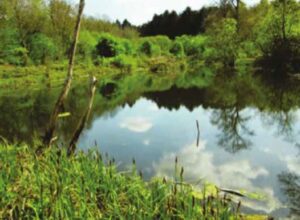However, GCN are now widespread within England and Wales, thanks to increased conservation efforts and awareness during the planning stages of developments. They occur only sparsely in Scotland, GCN are a designated European Protected Species (EPS) and thus are protected by law.
GCN occupy two types of habitats throughout the year, spending the majority of the year in terrestrial habitat such as grassland, woodland and scrub then hibernating over the winter months. However, usually between March and June, GCN migrate to water bodies to breed and lay eggs.
GCN rely on water for breeding, so on a walkover of a site, any ponds within a woodland, surrounded by sufficient undergrowth would potentially be suitable for GCN and should trigger further research to determine if GCN are likely to be present. Likewise, suitable terrestrial habitat could include dense undergrowth, timber/log piles, tree roots, mammal burrows, rock piles and tree cavities.
GCN are a difficult species to observe and usually are only encountered by chance and they can only be surveyed in depth at night within the breeding season. Where we are undertaking any work in woodlands with waterbodies present, it should be determined at an early stage whether there is potential for GCN to be present, as this could influence future forestry management practices.
If you think there is potential for GCN to be present on or near your site, contact the Tilhill Ecology Team for advice.




